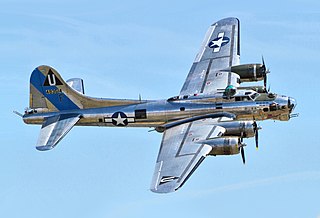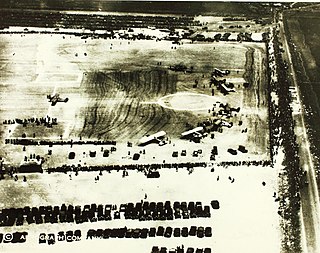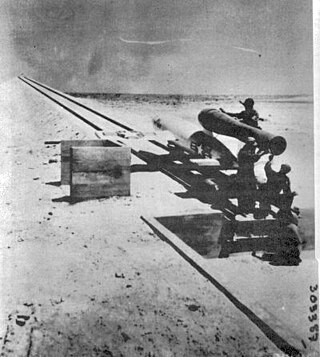
The Boeing B-17 'Flying Fortress' is an American four-engined heavy bomber developed in the 1930s for the United States Army Air Corps (USAAC). Fast and high-flying for a bomber of its era, the B-17 was used primarily in the European Theater of Operations and dropped more bombs than any other aircraft during World War II. It is the third-most produced bomber of all time, behind the American four-engined Consolidated B-24 Liberator and the German multirole, twin-engined Junkers Ju 88. It was also employed as a transport, antisubmarine aircraft, drone controller, and search-and-rescue aircraft.

The Boeing B-29 Superfortress is an American four-engined propeller-driven heavy bomber, designed by Boeing and flown primarily by the United States during World War II and the Korean War. Named in allusion to its predecessor, the B-17 Flying Fortress, the Superfortress was designed for high-altitude strategic bombing, but also excelled in low-altitude night incendiary bombing, and in dropping naval mines to blockade Japan. B-29s dropped the atomic bombs on Hiroshima and Nagasaki, the only aircraft ever to drop nuclear weapons in combat.

The Douglas C-54 Skymaster is a four-engined transport aircraft used by the United States Army Air Forces in World War II and the Korean War. Like the Douglas C-47 Skytrain derived from the DC-3, the C-54 Skymaster was derived from a civilian airliner, the Douglas DC-4. Besides transport of cargo, the C-54 also carried presidents, prime ministers, and military staff. Dozens of variants of the C-54 were employed in a wide variety of non-combat roles such as air-sea rescue, scientific and military research, and missile tracking and recovery. During the Berlin Airlift it hauled coal and food supplies to West Berlin. After the Korean War it continued to be used for military and civilian uses by more than 30 countries. It was one of the first aircraft to carry the President of the United States, the first being President Franklin D. Roosevelt during World War II.

Kirtland Air Force Base is a United States Air Force base. It is located in the southeast quadrant of the Albuquerque, New Mexico, urban area, adjacent to the Albuquerque International Sunport. The base was named for the early Army aviator Col. Roy C. Kirtland. The military and the international airport share the same runways, making ABQ a joint civil-military airport.

The Dole Air Race, also known as the Dole Derby, was a deadly air race across the Pacific Ocean from Oakland, California to Honolulu in the Territory of Hawaii held in August 1927. There were eighteen official and unofficial entrants; fifteen of those drew for starting positions, and of those fifteen, two were disqualified, two withdrew, and three aircraft crashed before the race, resulting in three deaths. Eight aircraft eventually participated in the start of the race on August 16, with only two successfully arriving in Hawaii; Woolaroc, a Travel Air 5000 piloted by Arthur C. Goebel and William V. Davis, arrived after a 26 hour, 15 minute flight, leading runner-up Aloha by two hours.

The Budd RB-1 Conestoga was a twin-engine, stainless steel cargo aircraft designed for the United States Navy during World War II by the Budd Company of Philadelphia, Pennsylvania. Although it did not see service in a combat theater, it pioneered design innovations in American cargo aircraft, later incorporated in modern military cargo airlifters.

Nine-O-Nine was a Boeing B-17G-30-BO Flying Fortress heavy bomber, of the 323d Bombardment Squadron, 91st Bombardment Group, that completed 140 combat missions during World War II, believed to be the Eighth Air Force record for most missions, without loss to the crews that flew her. A different B-17G, painted to mimic the Nine-O-Nine, crashed at Bradley International Airport in Windsor Locks, Connecticut, in October 2019.

Bomber Mountain is the crest of a ridge line within the Bighorn Mountains of the U.S. State of Wyoming. It borders the south side of Cloud Peak, the tallest peak in the range. It is about 23 miles (37 km) west of Buffalo. A military aviation accident that occurred upon the mountain in 1943 led to it being named Bomber Mountain in 1946. For more info see, "The Bomber Mountain Crash: A Wyoming Mystery" by Scott Madsen, Published and Copyrighted in September, 1990

Pan Am Flight 7 was a westbound round-the-world flight operated by Pan American World Airways. On November 8, 1957, the Boeing 377 Stratocruiser 10-29 serving the flight, named Clipper Romance of the Skies, crashed in the Pacific Ocean en route to Honolulu International Airport from San Francisco. The crash killed all 36 passengers and 8 crew members.

The 869th Bombardment Squadron is a former United States Army Air Forces unit. It was assigned to the 497th Bombardment Group, and was last stationed at MacDill Field, Florida where it was inactivated on 31 March 1946. The squadron was activated in late 1943. After training in the United States, it moved to Saipan in the Central Pacific Area, where it served in the strategic bombing campaign against Japan with Twentieth Air Force, flying Boeing B-29 Superfortress aircraft, where it earned two Distinguished Unit Citations. Following V-J Day, the squadron returned to the United States and briefly became part of Strategic Air Command before inactivating.
This is a partial list of accidents and incidents involving the Boeing-designed B-17 Flying Fortress. Combat losses are not included except for a very few cases denoted by singular circumstances. A few documented drone attrition cases are also included.

The 1st Experimental Guided Missiles Group is an inactive United States Air Force unit. It was last assigned to the Air Proving Ground Command and stationed at Eglin Air Force Base, Florida. It was inactivated on 22 July 1949.

Fairfax Field was a wartime (WWII) facility of the United States Army Air Forces and later, the United States Air Force. The installation was north of Kansas City, Kansas. Used as a pre-war Naval Air Station, the United States Army Air Forces leased the municipal airfield and built an Air Force Plant and modification center for North American B-25 Mitchell medium bomber production. Military use of the site continued as late as 1957 by the Strategic Air Command's 3903rd Radar Bomb Scoring Group for bombing practice.

Transair Flight 810 was a Boeing 737-200 converted freighter aircraft, owned and operated by Rhoades Aviation under the Transair trade name, on a short cargo flight en route from Honolulu International Airport to Kahului Airport on the neighboring Hawaiian island of Maui. Immediately after an early morning takeoff on July 2, 2021, one of its two Pratt & Whitney JT8D turbofan engines faltered, and the first officer, who was flying the aircraft, reduced power to both. The two pilots—who were the only aircraft occupants—began executing the Engine Failure or Shutdown checklist, but became preoccupied with talking to air traffic control (ATC) and performing other flying tasks, and never reached the section of the checklist where the failing engine was to be positively identified and shut down. The captain assumed control but misidentified the failing engine, increased power to that engine, and did not increase power to the other, properly functioning engine. Convinced that neither engine was working properly and unable to maintain altitude with one engine faltering and the other idling, the pilots ditched off the coast of Oahu about 11 minutes into the flight.













